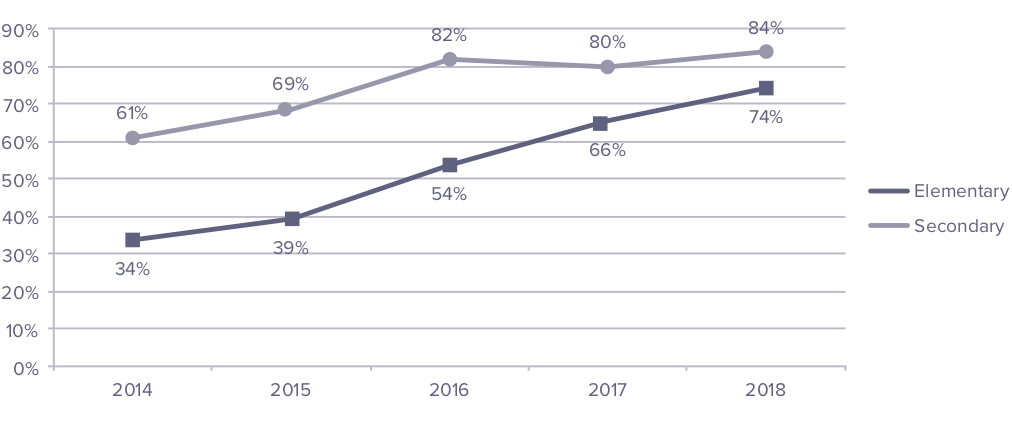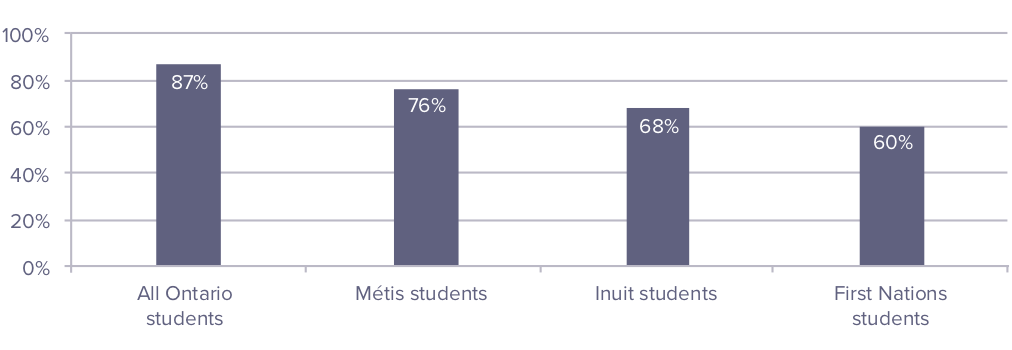Keeping up the momentum in Indigenous education
Schools across Ontario have been working hard to support Indigenous education initiatives, with some impressive results. However, there is still work to be done.
Ontario has a lot to be proud of in terms of Indigenous education. For the past four years, People for Education has been asking schools about the Indigenous education opportunities they provide. Over that time period, there has been a significant increase in the percentage of schools reporting that they offer Indigenous education opportunities such as cultural support programs, guest speakers, or professional development for teachers: from one third of elementary schools in 2014 to almost three quarters of schools in 2018.
In particular, the results from our 2018 Ontario School Survey show a notable increase in schools offering professional development and bringing in Indigenous guest speakers. In their survey responses, principals also pointed to a range of initiatives to support student learning and share Indigenous knowledge and perspectives, including Indigenous Studies courses, land acknowledgements, Orange Shirt Day, medicine gardens, and Indigenous language programs.
Percentage of schools offering Indigenous education opportunities:

More work to be done
While the survey results show substantial progress in Indigenous education, there are also areas for continued work and improvement. When the province’s Indigenous Education Framework was introduced, the province committed to closing the achievement gap between Indigenous and non-Indigenous students, and to working with First Nation, Métis, and Inuit partners and key education stakeholders to “explore and identify additional indicators of student achievement…well-being and self-esteem.” However, little progress has been made on developing new ways to measure success beyond literacy and numeracy test scores, and Indigenous students are still graduating at rates below the average for Ontario students. In 2018, the province-wide graduation rate is 87% after five years of secondary school. For First Nations students, this rate is only 60%.
Graduation rates for students after five years of secondary school

Will this momentum slow down?
In 2016, in response to the Truth and Reconciliation Commission (TRC) report, the province reported that it was working with Indigenous partners to “support mandatory learning about residential schools, the legacy of colonialism, and the rights and responsibilities we all have to each other as treaty people” (p. 19, The Journey Together).
This work may have hit a roadblock.
In July 2018, the Ontario government canceled all curriculum-writing sessions, including those that would have continued the process of updating the province’s curriculum documents to include Indigenous perspectives and content.
A holistic vision for education
People for Education has been calling for the inclusion of competencies in social-emotional learning, creativity, health, and citizenship in the curriculum and the goals for Ontario’s education system. According to Dr. Pamela Rose Toulouse, this is well-aligned with Indigenous perspectives of education. Indigenous peoples hold a holistic view of education that extends beyond current success measures and includes physical, emotional, intellectual, and spiritual balance.
“Student achievement for Indigenous Nations is based on a birth to death continuum that is holistic and devoted to interconnectedness” – Toulouse, 2014
In June 2018, People for Education recommended that the province act on its 2014 commitment and work with Indigenous leaders and scholars to establish a new set of indicators of student success that are more congruent with the interests, needs, and motivation of Indigenous communities, and vital for all students’ success in school and life.
Read the chapter on Indigenous education from the Annual Report on Ontario’s Publicly Funded Schools 2018.
